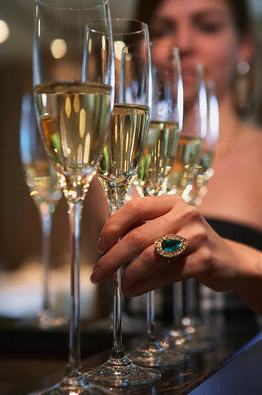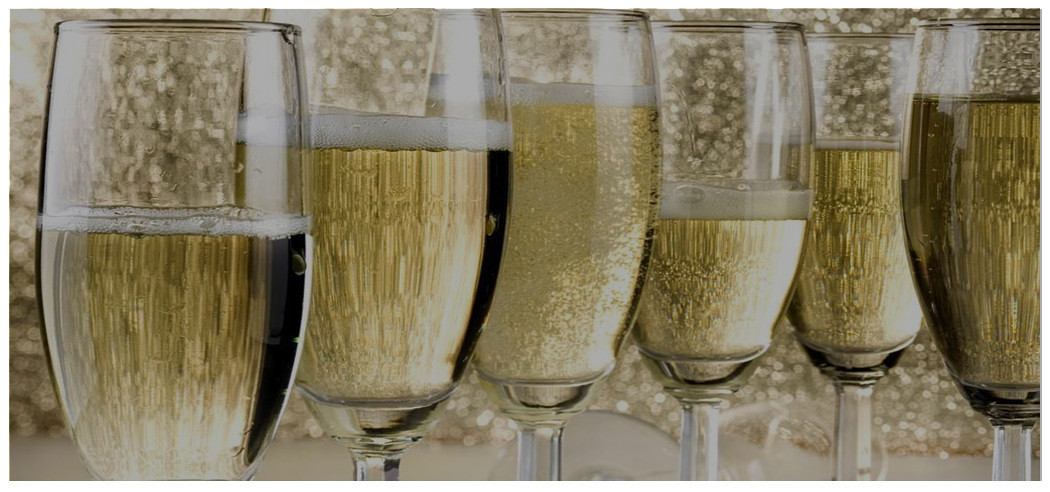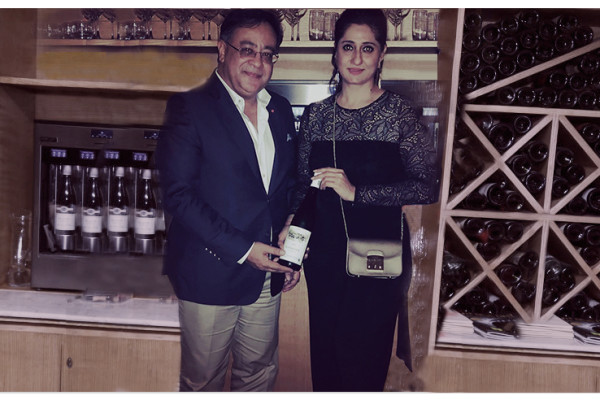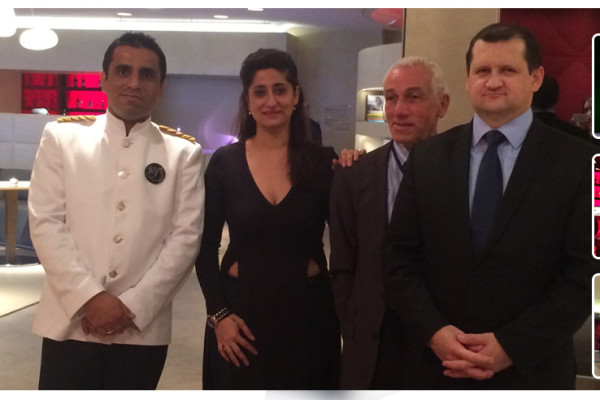Grapes Used to Make Champagne
Genuine Champagne uses only three varieties of grapes: Chardonnay, Pinot Noir and Pinot Meunier Rosé and blanc de noirs: Made with the addition of red or black grapes, Blanc de blancs: Produced only from chardonnay grapes

Champagne Varieties
To help navigate your choices to suit your palate.
- Brut – Very dry and flexible for a range of dishes that do not require sweet infusion.
- Extra Dry – Less dry and generally used as brut.
- Dry – With some sugar; can be blended into recipes for a hint of sweetness.
- Demi-sec – Sweet; most often used to pair with less-sugary fruits.
- Doux – Very sweet, although not as much as true dessert wines.
- Cremant champagnes: Made with half the effervescence.
Champagne Glossary
A
A.O.C. — Abbreviation for Appellation d’Origine Contrôlée, the government agency that controls wine production in France.
Appellation — A geographical based term to identify where the grapes for a wine were grown.
B
Barrel — A hollow cylindrical container, traditionally made of wood staves, used for fermenting and aging wine. Sometimes called a cask.
Barrique — The French name for a 225 litre Bordeaux style barrel.
BlancdeBlanc — Is an elegant white sparkling wine or Champagne. It is made exclusively from white grapes (Chardonnay or Pinot Blanc).
BlancdeNoir — A full-bodied Champagne or sparkling wine made from black grapes (Pinot Noir or Pinot Meunier).
Body — The sense of weight imparted by a wine to the mouth of a taster. A wine may be light- or full-bodied.
Brut — A French term for a very dry champagne or sparkling wine. Drier than extra dry.
C
Cava — A white or pink sparkling wine produced in Spain mainly from the Penendes region in Catalonia. The word Cava comes from the Latin word which translates to the English word cave. Caves were used in the early days of cava production to store, preserve and age wine.
Champagneflute — A piece of stemware having a long stem with a tall, narrow bowl on top.
Chaptalization — A winemaking process where sugar is added to the must to increase the alcohol content in the fermented wine. This is often done when grapes have not ripened adequately.
Charmat — The Charmat method uses large and pressurized stainless steel tanks for the sparkling wines’ secondary fermentation. This process allows for the rapid stimulation of fresh yeast and sugar to ferment in the pressurized tanks.
Cold Duck — A mixture of red and white sparkling wine that has a high sugar content.
Crémant — French sparkling wine not made in Champagne region.
Cuvé — A large vat used for fermentation.
Cuvée — The pressing, or a blending of several wines.
D
Dégorgement — The disgorging or removal of sediment from bottles that results from secondary fermentation.
Demi–sec — Moderately sweet to medium sweet sparkling wines.
DO — The abbreviation for Denominación de Origen, or “place name.” This is Spain’s designation for wines whose name, origin of grapes, grape varieties and other important factors are regulated by law.
DOC — The abbreviation for Denominazione di Origine Controllata, or “controlled place name.” This is Italy’s designation for wine whose name, origin of grapes, grape varieties and other important factors are regulated by law. It is also the abbreviation for Portugal’s highest wine category, which has the same meaning in that country.
DOCG — The abbreviation for Denominazione di Origine Controllata e Garantita, or controlled and guaranteed place name, which is the category for the highest-ranking wine in Italy.
Doux — The French word for sweet. Usually refers to the sweetest category of sparkling wines.
E
en Tirage — French for “in pulling”, refers to the period of time in which bottled sparkling wine is rested in contact with lees generated during secondary fermentation. Part of the Méthode Champenoise process.
Extra dry — A champagne or sparkling wine with a small amount of residual sugar (slightly sweet). Not as dry as Brut.
F
Fermentation — The conversion of grape sugars to alcohol by yeast.
Finish — A tasting term for the lingering aftertaste after a wine has been swallowed.
Flabby — Tasting term used to indicate a wine lacking in structure, often marked by low acidity.
G
Grapejuice — The free-run or pressed juice from grapes. Unfermented grape juice is known as “must.”
I
IGT — Abbreviation for “Indicazione Geografica Tipica”, the lowest-ranking of the three categories of Italian wine regulated by Italian law.
M
MéthodeChampenoise — Process whereby sparkling wines receive a second fermentation in the same bottle that will be sold to a retail buyer. Compare with Charmat or bulk fermented.
Mousse — The foamy head that forms at the top of the glass of champagne.
Must — Grape juice before it’s fermented, including pips, skins and stalks.
R
Racking — The process of drawing wine off the sediment, such as lees, after fermentation and moving it into another vessel.
Riddling — Also known as “Rémuage” in French, this is a part of the Méthode Champenoise process whereby bottles of sparkling wine are successively turned and gradually tilted upside down so that sediment settles into the necks of the bottles in preparation for dégorgement.
S
Sekt — German sparkling wine.
Sparklingwine — Effervescent wine containing significant levels of carbon dioxide.
Spumante — Italian for “sparkling”. Generally any sparkling wine from Italy, although producers of Franciacorta (wine) have recently started stating that Franciacorta is not a “spumante”.
Stillwine — Wine that is not sparkling wine.
Sur Lies — Pronounced soar lees, is the contact of the wine with the yeast in barrels for a longer period of time. Generally, this can produce a richer and higher quality wine.
T
Tannin — Polyphenolic compounds that give wine a bitter, dry, or puckery feeling in the mouth.
Tart — A tasting term describing a wine high in acidity. Often displayed by young, unripe wines.
Texture — A tasting term for the mouthfeel of wine on the palate.
U
Ullage — Also known as headspace, the unfilled space in a wine bottle, barrel, or tank.
Unoaked — Also known as unwooded, refers to wines that have been matured without contact with wood/oak such as in aging barrels.
V
Varietal — Wines made from a single grape variety.
Vintage — The year in which a particular wine’s grapes were harvested. When a vintage year is indicated on a label, it signifies that all the grapes used to make the wine in the bottle were harvested in that year.
Y
Yeast — A microscopic unicellular fungi responsible for the conversion of sugars in must to alcohol. This process is known as alcoholic fermentation.
Young — Wine that is not matured and usually bottled and sold within a year of its vintage.
*Glossary descriptions courtesy of www.taste-wine-and-enjoy.com
When Bubbly is Not Champagne
A bubbly is not truly a Champagne unless it comes directly from the region of Champagne France. Outside this region, there are many sparkling wines that can be procesed in the authentic way but these are not actual champagnes. They include Spumante (Italy) Spekt (Germany).



